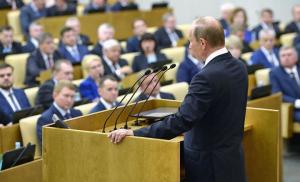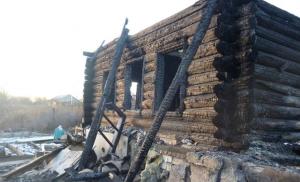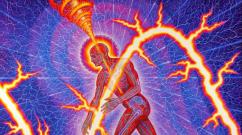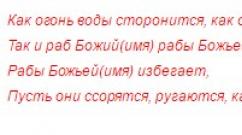Who is Tikhon Zadonsky? Saint Tikhon, Bishop of Voronezh, Wonderworker of Zadonsk
Audio
(fragments of the sermon of His Eminence Arseny, Metropolitan of Svyatogorsk on the day of memory of St. Tikhon of Zadonsk, 08/26/2009)
“Orthodoxy mentor, piety to the teacher,
preacher of repentance, zealot of Chrysostom, good shepherd"
(from the troparion to the saint)
The veneration of this saint of God existed during his lifetime, and the saint’s prayers were always effective and heard by God. In addition, he left behind many of his spiritual children, many of whom became famous for their gifts of miracles and clairvoyance, and later their incorruptible relics rested in the Zadonsk monastery. When it was closed in Soviet times, these relics of his students, withered and incorrupt, were loaded onto carts with pitchforks, the atheists took them away and buried them in the Zadonsk city cemetery, having previously broken the relics with stones.
A miracle that happened on the feast of the glorification of St. Tikhon
![]()
After the death of Saint Tikhon, his veneration did not cease in the Zadonsk monastery, and constantly many people went to his tomb for consolation. And in the 1860s the question arose about his glorification as a saint.
It was assumed that a lot of people would come to Zadonsk for this event. And on the eve of glorification, the following miracle happened. The Zadonsk merchants, having reasoned among themselves that a lot of people would come to the city, decided to build a whole street of hotels, where they planned to rent out rooms to visiting pilgrims for a high fee. And they agreed among themselves that they would even sell water for money. And a whole street of hotels was built in the city.
Next to these hotels on the same street stood the house of a poor widow. She, not knowing how she could serve Saint Tikhon, but sincerely honoring the saint of God, covered her entire yard with straw and bought several tubs of pickled cucumbers. So that the pilgrims who come for the glorification of St. Tikhon can at least rest on straw and have something for a meal, at least bread with cucumbers.
Many people gathered for the glorification of Saint Tikhon. And so, on the eve of the holiday, lightning suddenly struck out of a clear sky, setting all the hotels in the city of Zadonsk on fire. New buildings caught fire and burned like gunpowder. The widow's house and her yard, covered completely with straw, remained unaffected by the fire - not even a single straw was smoldered there. And this widow’s house remained safe and sound among two rows of charred hotels, as if exposing the unclean plans of the would-be builders.
And the Zadonsk merchants, seeing such a reproof from Saint Tikhon himself and such admonition from God, publicly brought repentance to the temple of the Zadonsk monastery. They repented of their selfishness and brought repentance for their madness, that they wanted to turn the memory of the saint of God into their own selfishness and benefit.
Procession of the Cross on the Feast of the Glorification of St. Tikhon

As eyewitnesses say, up to three hundred thousand people were present at the glorification of St. Tikhon - so many that the sick were passed over their heads just to be attached to the relics of St. Tikhon. But, despite this, during the holiday there was no stampede, and not a single person was hurt or died, but there were many healed. The procession around the Zadonsk Monastery with the relics of St. Tikhon lasted for several hours. He moved extremely slowly, because the people, out of zeal for their beloved saint, carried with them canvases of linen woven by their toiling hands, and threw these canvases along the path of the religious procession. And they threw these canvases up to 6 meters wide and up to a meter thick around the Zadonsky Monastery, so that the clergy walked and their feet got tangled in the canvases, which is why the religious procession moved extremely slowly.
Since then, the memory of Saint Tikhon has always gathered and continues to gather many people to the Zadonsk monastery.
Appearance of Saint Tikhon inGreat Patriotic War
There was an appearance of Saint Tikhon recently during the Great Patriotic War. Residents of the city of Yelets saw Saint Tikhon as he appeared in the city cemetery at the grave of the blessed elder Cosmas. Approaching the tomb and knocking on it with his staff, the saint said: “Get up, brother Cosmas, let’s go to the city of Yelets and our fatherland to defend.”
During the Soviet period, the relics of St. Tikhon were first transferred to Orlov, when the Zadonsky Monastery was closed. In the city of Orel they were in the cathedral, and in 1991 they were solemnly returned to the city of Zadonsk at the opening of the Zadonsk monastery.
Return of the relics of St. Tikhon to Zadonsk: memories of Bishop Arseny
The Lord destined me to participate in the return of the holy relics of St. Tikhon to the city of Zadonsk. This, brothers and sisters, was the greatest triumph. After the godless Soviet period, the believing people, yearning for church services and for the open confession of the Christian faith, gathered in large numbers in Zadonsk.

We took a school bus from our village and, together with 20 fellow villagers, went to Zadonsk. Even approaching 20-30 km before Zadonsk, we saw many people walking to this city. Of course, we put as many people on the bus as we could and gave them rides, but a huge number of believers continued their journey on foot.
And when we arrived at the monastery, we saw that transport was not allowed into the city, and it was only possible to travel along the ring road, everything was so packed with people. A lot of people stood at the entrance to the city, there were crowds along the street, waiting for the relics of St. Tikhon to be brought, there were also a lot of people in the monastery, in the cathedral church.
And so they brought Saint Tikhon. People stood on the roofs, in the windows of houses, on building materials piled up on the monastery territory - the monastery had just opened and construction and repair work was beginning in it. It was such a great celebration, a special celebration that made a special impression and evoked tears of joy and tenderness. Saint Tikhon of Zadonsk was returning to his monastery, to his flock. And to this day, Saint Tikhon of Zadonsk rests with his relics in the Zadonsk monastery.
Saint Tikhon of Zadonsk and the Svyatogorsk Monastery

A particle of his holy relics is also kept in our monastery - in the icon that lies in the side chapel. This chapel of the Assumption Cathedral is dedicated to three Russian saints - Demetrius of Rostov, Mitrofan of Voronezh and Tikhon of Zadonsk.

The troparion and kontakion for these saints of God, in joint memory of them, was compiled by Saint Innocent of Kherson, a native of the city of Yelets and an admirer of Saint Tikhon.

And a chapel was established here in honor of St. Tikhon for the following reason. At one time, our abbot, traveling to Moscow, became seriously ill on the road in the winter, so much so that in Voronezh they were already carrying him out of the cart in their arms, and the cell attendant who accompanied him already thought that the Monk Herman would not return to the monastery alive.
At the relics of Saint Mitrophan he received some relief from his illness, and ordered to move on. But on the way to Zadonsk he again became worse. So they carried him to Zadonsk in their arms and wanted to carry him to the hotel cell, but he said: “Carry me to the temple to St. Tikhon.” They brought him to the temple. The monk asked to be put on his feet, and supported by his arms, with the last of his strength, crossing himself, he knelt down and bowed to the ground before the relics of St. Tikhon. And as he himself later said, “When I got up from bowing, I suddenly felt as if some kind of force had penetrated me. I bowed down as a hopelessly ill person, and stood up absolutely healthy, full of strength and energy. After the prayer service to Saint Tikhon, he went to drink tea with the abbot of the Zadonsk Monastery. I made the journey to Moscow absolutely healthy, there was no trace left of my illness.” In gratitude for his healing, our abbot founded a throne in the left chapel of the Holy Dormition Cathedral of our monastery, dedicating it to three saints - Demetrius of Rostov, Mitrofan of Voronezh and Tikhon of Zadonsk. And we see a large icon in the iconostasis, which depicts these three saints together.

Continuous miracles of healing
Saint Tikhon, brothers and sisters, has poured out and continues to pour out many miracles to this day.
Thus, in the Voronezh diocese there is a long-standing pious tradition: on August 20, on the day of remembrance of St. Mitrophan of Voronezh, after serving the Divine Liturgy on the feast day of the patron saint of the Voronezh diocese - St. Mitrofan, a procession of the cross leaves the cathedral and proceeds to the city of Zadonsk.


From August 20 to August 26 (before the day of remembrance of St. Tikhon), the procession on foot goes 90 kilometers from village to village, from temple to temple. At rural churches, awnings and meals for pilgrims are supplied, people spend the night in churches encountered along the way, and the solemn procession of the cross, according to the good ancient pre-revolutionary tradition, enters the city of Zadonsk on the 25th, on the eve of the memory of St. Tikhon, where it is solemnly met by the brethren of the Zadonsk monastery and numerous pilgrims.
This tradition, brothers and sisters, exists in our time, and people who participated in religious processions dedicated to St. Mitrofan and St. Tikhon testified that during the religious procession, many of them went to the religious procession sick and returned healthy. Even incurable diseases were healed, which, it would seem, even doctors had already refused to treat and had given up.
(Based on materials from the websites: Voronezh Metropolis and).
“It is not enough to honor the saint of God just by remembering his life”: instructions from the Bishop of the Viceroy
Saint Tikhon of Zadonsk to this day has remained and remains a good shepherd to his flock. And today we, brothers and sisters, his flock, instructed by his teachings, gathered in holy churches to honor his holy memory.
But it is not enough to honor the saint of God just by remembering his life. If, brothers and sisters, you come across his theological and pastoral works, which are published in great numbers in our time, the works of St. Tikhon of Zadonsk, then try to buy these books and read them. These are words that themselves fall on the soul, on the heart, turn all our thoughts upside down, change all our feelings for the good. And, besides, reading the works of Saint Tikhon, left by him, we, brothers and sisters, will feel as if we are talking with Saint Tikhon himself. And this conversation of St. Tikhon, his instructions through his theological works - let them be for us the living word of a shepherd who saves our souls not so much with his theological creations, not only with the example of his life given to us for imitation, but also, in addition, with your prayers in the Heavenly Kingdom at the throne of the Almighty. Amen!
Saint Tikhon of Zadonsk. Gallery of Shchigry icons.
Saint Tikhon of Zadonsk, Bishop of Voronezh (in the world Timothy), was born in 1724 in the village of Korotsk, Novgorod diocese, into the family of sexton Savely Kirillov. (The new surname - Sokolov - was assigned to him later by the authorities of the Novgorod Seminary). From early childhood, after the death of his father, he lived in such need that his mother almost gave him up to be raised by a neighbor, a coachman, since there was nothing to feed the family. Eating only black bread and then very restrainedly, the boy hired himself out to rich gardeners to dig beds. As a thirteen-year-old boy, he was sent to a theological school at the Novgorod bishop's house, and in 1740 he was accepted for government support into a seminary established in Novgorod.
Saint Tikhon of Zadonsk. Fresco on Vladimir Cathedral.
The young man studied excellently and, upon graduating from the seminary in 1754, was retained there as a teacher, first of Greek, then of rhetoric and philosophy. In 1758 he took monastic vows with the name Tikhon. In the same year he was appointed to the position of prefect of the seminary. In 1759 he was transferred to Tver with his elevation to the rank of Archimandrite of the Zheltikov Monastery. Then he was appointed rector of the Tver Seminary and at the same time abbot of the Otroch Monastery. On May 13, 1761, he was consecrated Bishop of Kexholm and Ladoga (vicar of the Novgorod diocese). The dedication was providential. The young archimandrite was supposed to be transferred to the Trinity-Sergius Lavra, but in St. Petersburg, during the election of the Novgorod vicar, on Easter, his name was taken out of 8 lots three times.

On the same day, His Grace Athanasius of Tver, against his will, remembered him at the Cherubim Song (at the altar) as a bishop.
In 1763 the saint was transferred to the Voronezh see. For four and a half years, ruling the Voronezh diocese, Saint Tikhon constantly edified it with his life and numerous pastoral instructions and soul-saving books. He wrote a number of works for pastors: “On the Seven Holy Mysteries”, “Addition to the Priestly Office”, “On the Sacrament of Repentance”, “Instructions on Marriages”. The saint especially demanded that every clergyman have the New Testament and read it daily. In his “District Epistle” he called on pastors to reverently perform the sacraments, to be mindful of God and to show brotherly love. (“Instruction on the duties of every Christian” was republished many times in Moscow and St. Petersburg already in the 18th century). In Voronezh, the saint eradicated an ancient pagan custom - a celebration in honor of Yarila. Within the location of the Don Cossack army, he opened a missionary commission to convert schismatics to the Orthodox Church. In 1765, Saint Tikhon transformed the Voronezh Slavic-Latin school into a theological seminary and, inviting experienced teachers from Kyiv and Kharkov, developed educational programs for it.

Saint Tikhon, Bishop of Zadonsk, Saint Alexy, Metropolitan of Moscow, Saint Simeon the Stylite. Fresco on the Vladimir Cathedral of the Zadonsk Nativity of the Theotokos Monastery.
He had to put in a lot of effort and labor to set up churches, schools, instruct and enlighten the shepherds, and convince them of the need for education. Governing a vast diocese, the saint did not spare his strength, often spending nights without sleep. In 1767, due to poor health, he was forced to leave the administration of the diocese and retire to the Tolshevsky Monastery, which was located 40 versts from Voronezh. In 1769, the saint moved to the Bogoroditsky Monastery in the city of Zadonsk. Having settled in this monastery, Saint Tikhon became a great teacher of Christian life. With deep wisdom, he developed the ideal of true monasticism - “Rules of monastic life” and “Instructions for those who have turned from the vain world” - and embodied this ideal in his life. He strictly observed the statutes of the Church, zealously (almost daily) visited the churches of God, often sang and read in the choir, and over time, out of humility, completely abandoned participation in the services and stood at the altar, reverently protecting himself with the sign of the cross.
His favorite cell pastime was reading the lives of saints and patristic works. He knew the Psalter by heart and usually read or sang psalms on the way. The saint endured many temptations, lamenting the forced abandonment of his flock. Having recovered his health, he was going to return to the Novgorod diocese, where Metropolitan Gabriel invited him to take the place of rector at the Iveron Valdai Monastery. When the cell attendant announced this to Elder Aaron, he said: “Why are you raging? The Mother of God does not order him to leave here.” The cell attendant conveyed this to the Right Reverend. “If so,” said the saint, “I will not leave from here,” and tore up the petition. Sometimes he went to the village of Lipovka, where he himself performed divine services in the Bekhteevs’ house. The saint also went to the Tolshevsky Monastery, which he loved for its solitude.
The fruit of his entire spiritual life were the works that the saint completed in retirement: “Spiritual Treasure Collected from the World” (1770), as well as “On True Christianity” (1776). The saint lived in the simplest surroundings: he slept on straw, covering himself with a sheepskin coat. His humility reached the point that the saint did not pay attention to the ridicule that often rained down on him, pretending that he did not hear them, and said afterwards: “God so pleases that the ministers laugh at me - I deserve it for my sins.” my". He often said in such cases: “Forgiveness is better than revenge.”
One day the holy fool Kamenev hit the saint on the cheek with the words “don’t be arrogant” - and the saint, taking this with gratitude, fed the holy fool every day.
All his life, the saint “thou joyfully endured vexation, sorrow, and insult, thinking that there is a crown without victory, victory without feat, feat without battle, and there is no battle without enemies” (canto 6 of the canon).
Strict with himself, the saint was lenient with others. One Friday before the Vaiy holiday, he entered the cell of his friend Schemamonk Mitrofan and saw him at the table with Kozma Ignatievich, a resident of Yelets, whom he also loved. There was fish on the table. Friends were embarrassed. The good saint said: “Sit down, I know you, love is higher than fasting.” And to calm them down even more, he tasted the fish soup himself. He especially loved the common people, consoled them in their difficult times, interceding before the landowners, whom he constantly admonished to be merciful. He gave all his pension and the offerings of his admirers to the poor.
Through exploits of self-denial and love, the soul of the saint rose to the contemplation of Heaven and insights into the future. In 1778, in a subtle dream, he had the following vision: the Mother of God stood on the clouds and near her were the apostles Peter and Paul; The saint himself, on his knees, asked the Most Pure One for continued mercy to the world. The Apostle Paul said loudly: “Whenever they proclaim peace and confirmation, then will sudden destruction come upon them.” The saint woke up in trepidation and in tears. The next year he again saw the Mother of God in the air and several faces around her; the saint fell to his knees, and four men dressed in white robes fell to their knees near him. The saint asked the Most Pure One for someone, so that he would not move away from him (who these persons were and for whom the request was made, the saint did not tell the cell attendant), and She answered: “It will be according to your request.”
Saint Tikhon predicted many of the destinies of Russia, in particular he spoke about the victory of Russia in the Patriotic War of 1812. More than once the saint was seen in spiritual admiration, with a changed and enlightened face, but he forbade talking about it. Three years before his death, he prayed every day: “Tell me, Lord, my death.” And a quiet voice at dawn said: “On the day of the week.” That same year, he saw in a dream a beautiful ray with wonderful chambers on it and wanted to enter the doors, but they told him: “In three years you can enter, but now work hard.” After this, the saint locked himself in a cell and received only rare friends. The saint had clothes and a coffin prepared for his death: he often came to cry over his coffin, which stood hidden from people in a closet. A year and three months before his death, in a subtle dream, the saint imagined that he was standing in the side chapel of the monastery church and a familiar priest carried a veiled baby from the altar to the royal doors. The saint approached and kissed the Child on the right cheek, and he hit him on the left.
Upon awakening, the saint felt numbness in his left cheek, left leg and shaking in his left hand. He accepted this illness with joy. Shortly before his death, the saint saw in a dream a high and steep staircase and heard the command to climb it. “I,” he told his friend Kozma, “at first was afraid of my weakness. But when I began to ascend, the people standing near the stairs seemed to lift me higher and higher to the very clouds.” “The ladder,” explained Kozma, “is the path to the Kingdom of Heaven; those who helped you are those who use your instructions and will remember you.” The saint said with tears: “I think the same thing myself: I feel the approach of death.” During his illness, he often received Holy Communion.
Saint Tikhon died, as it was announced to him, on Sunday August 13, 1783, at the 59th year of his life. The glorification of the saint also took place on Sunday, August 13, 1861.
Troparion of St. Tikhon
Orthodoxy mentor, piety teacher,
preacher of repentance, Chrysostom zealot,
good shepherd,
the new Russia is a luminary and miracle worker,
Thou hast well preserved thy flock
and with your writings you have instructed us all,
also the crown of incorruption
decorated from the Chief Shepherd,
pray to Him for the salvation of our souls.
Saint Tikhon of Zadonsk, Bishop of Voronezh (in the world Timothy), was born in 1724 in the village of Korotsk, Novgorod diocese, into the family of sexton Savely Kirillov. (The new surname - Sokolov - was assigned to him later by the authorities of the Novgorod Seminary). From early childhood, after the death of his father, he lived in such need that his mother almost gave him up to be raised by a neighbor, a coachman, since there was nothing to feed the family. Eating only black bread and then very restrainedly, the boy hired himself out to rich gardeners to dig beds. As a thirteen-year-old boy, he was sent to a theological school at the Novgorod bishop's house, and in 1740 he was accepted for government support into a seminary established in Novgorod. The young man studied excellently and, upon graduating from the seminary in 1754, was retained there as a teacher, first of Greek, then of rhetoric and philosophy. In 1758 he took monastic vows with the name Tikhon. In the same year he was appointed to the position of prefect of the seminary. In 1759 he was transferred to Tver with his elevation to the rank of Archimandrite of the Zheltikov Monastery. Then he was appointed rector of the Tver Seminary and at the same time abbot of the Otroch Monastery. On May 13, 1761, he was consecrated Bishop of Kexholm and Ladoga (vicar of the Novgorod diocese). The dedication was providential. The young archimandrite was supposed to be transferred to the Trinity-Sergius Lavra, but in St. Petersburg, during the election of the Novgorod vicar, on Easter, his name was taken out of 8 lots three times.
On the same day, His Grace Athanasius of Tver, against his will, remembered him at the Cherubim Song (at the altar) as a bishop.
In 1763 the saint was transferred to the Voronezh see. For four and a half years, ruling the Voronezh diocese, Saint Tikhon constantly edified it with his life and numerous pastoral instructions and soul-saving books. He wrote a number of works for pastors: “On the Seven Holy Mysteries”, “Addition to the Priestly Office”, “On the Sacrament of Repentance”, “Instructions on Marriages”. The saint especially demanded that every clergyman have the New Testament and read it daily. In his “District Epistle” he called on pastors to reverently perform the sacraments, to be mindful of God and to show brotherly love. (“Instruction on the duties of every Christian” was republished many times in Moscow and St. Petersburg already in the 18th century). In Voronezh, the saint eradicated an ancient pagan custom - a celebration in honor of Yarila. Within the location of the Don Cossack army, he opened a missionary commission to convert schismatics to the Orthodox Church. In 1765, Saint Tikhon transformed the Voronezh Slavic-Latin school into a theological seminary and, inviting experienced teachers from Kyiv and Kharkov, developed educational programs for it. He had to put in a lot of effort and labor to set up churches, schools, instruct and enlighten the shepherds, and convince them of the need for education. Governing a vast diocese, the saint did not spare his strength, often spending nights without sleep. In 1767, due to poor health, he was forced to leave the administration of the diocese and retire to the Tolshevsky Monastery, which was located 40 versts from Voronezh. In 1769, the saint moved to the Bogoroditsky Monastery in the city of Zadonsk. Having settled in this monastery, Saint Tikhon became a great teacher of Christian life. With deep wisdom, he developed the ideal of true monasticism - “Rules of monastic life” and “Instructions for those who have turned from the vain world” - and embodied this ideal in his life. He strictly observed the statutes of the Church, zealously (almost daily) visited the churches of God, often sang and read in the choir, and over time, out of humility, completely abandoned participation in the services and stood at the altar, reverently protecting himself with the sign of the cross. His favorite cell pastime was reading the lives of saints and patristic works. He knew the Psalter by heart and usually read or sang psalms on the way. The saint endured many temptations, lamenting the forced abandonment of his flock. Having recovered his health, he was going to return to the Novgorod diocese, where Metropolitan Gabriel invited him to take the place of rector at the Iveron Valdai Monastery. When the cell attendant announced this to Elder Aaron, he said: “Why are you raging? The Mother of God does not order him to leave here.” The cell attendant conveyed this to the Right Reverend. “If so,” said the saint, “I will not leave from here,” and tore up the petition. Sometimes he went to the village of Lipovka, where he himself performed divine services in the Bekhteevs’ house. The saint also went to the Tolshevsky Monastery, which he loved for its solitude.
The fruit of his entire spiritual life were the works that the saint completed in retirement: “Spiritual Treasure Collected from the World” (1770), as well as “On True Christianity” (1776).
The saint lived in the simplest surroundings: he slept on straw, covering himself with a sheepskin coat. His humility reached the point that the saint did not pay attention to the ridicule that often rained down on him, pretending that he did not hear them, and said afterwards: “God so pleases that the ministers laugh at me - I deserve it for my sins.” my". He often said in such cases: “Forgiveness is better than revenge.”
One day the holy fool Kamenev hit the saint on the cheek with the words “don’t be arrogant” - and the saint, taking this with gratitude, fed the holy fool every day.
All his life, the saint “thou joyfully endured vexation, sorrow, and insult, thinking that there is a crown without victory, victory without feat, feat without battle, and there is no battle without enemies” (canto 6 of the canon).
Strict with himself, the saint was lenient with others. One Friday before the Vaiy holiday, he entered the cell of his friend Schemamonk Mitrofan and saw him at the table with Kozma Ignatievich, a resident of Yelets, whom he also loved. There was fish on the table. Friends were embarrassed. The good saint said: “Sit down, I know you, love is higher than fasting.” And to calm them down even more, he tasted the fish soup himself. He especially loved the common people, consoled them in their difficult times, interceding before the landowners, whom he constantly admonished to be merciful. He gave all his pension and the offerings of his admirers to the poor.
Through exploits of self-denial and love, the soul of the saint rose to the contemplation of Heaven and insights into the future. In 1778, in a subtle dream, he had the following vision: the Mother of God stood on the clouds and the apostles Peter and Paul were near her; The saint himself, on his knees, asked the Most Pure One for continued mercy to the world. The Apostle Paul said loudly: “Whenever they proclaim peace and confirmation, then will sudden destruction come upon them.” The saint woke up in trepidation and in tears. The next year he again saw the Mother of God in the air and several faces around her; the saint fell to his knees, and four men dressed in white robes fell to their knees near him. The saint asked the Most Pure One for someone, so that he would not move away from him (who these persons were and for whom the request was made, the saint did not tell the cell attendant), and She answered: “It will be according to your request.” Saint Tikhon predicted many of the destinies of Russia, in particular he spoke about the victory of Russia in the Patriotic War of 1812. More than once the saint was seen in spiritual admiration, with a changed and enlightened face, but he forbade talking about it. Three years before his death, he prayed every day: “Tell me, Lord, my death.” And a quiet voice at dawn said: “On the day of the week.” That same year, he saw in a dream a beautiful ray with wonderful chambers on it and wanted to enter the doors, but they told him: “In three years you can enter, but now work hard.” After this, the saint locked himself in a cell and received only rare friends. The saint had clothes and a coffin prepared for his death: he often came to cry over his coffin, which stood hidden from people in a closet. A year and three months before his death, in a subtle dream, the saint imagined that he was standing in the side chapel of the monastery church and a familiar priest carried a veiled baby from the altar to the royal doors. The saint approached and kissed the Child on the right cheek, and he hit him on the left. Upon awakening, the saint felt numbness in his left cheek, left leg and shaking in his left hand. He accepted this illness with joy. Shortly before his death, the saint saw in a dream a high and steep staircase and heard the command to climb it. “I,” he told his friend Kozma, “at first was afraid of my weakness. But when I began to ascend, the people standing near the stairs seemed to lift me higher and higher to the very clouds.” “The ladder,” explained Kozma, “is the path to the Kingdom of Heaven; those who helped you are those who use your instructions and will remember you.” The saint said with tears: “I think the same thing myself: I feel the approach of death.” During his illness, he often received Holy Communion.
Saint Tikhon died, as it was announced to him, on Sunday August 13, 1783, at the 59th year of his life. The glorification of the saint also took place on Sunday, August 13, 1861.
Saint Tikhon of Zadonsk, Bishop of Voronezh (in the world Timothy), was born in 1724 in the village of Korotsk, Novgorod diocese, into the family of sexton Savely Kirillov. (The new surname - Sokolov - was assigned to him later by the authorities of the Novgorod Seminary). From early childhood, after the death of his father, he lived in such need that his mother almost gave him up to be raised by a neighbor, a coachman, since there was nothing to feed the family. Eating only black bread and then very restrainedly, the boy hired himself out to rich gardeners to dig beds.
As a thirteen-year-old boy, he was sent to a theological school at the Novgorod bishop's house, and in 1740 he was accepted for government support into a seminary established in Novgorod. The young man studied excellently and, upon graduating from the seminary in 1754, was retained there as a teacher, first of Greek, then of rhetoric and philosophy. In 1758 he took monastic vows with the name Tikhon. In the same year he was appointed to the position of prefect of the seminary. In 1759 he was transferred to Tver with his elevation to the rank of Archimandrite of the Zheltikov Monastery. Then he was appointed rector of the Tver Seminary and at the same time abbot of the Otroch Monastery. On May 13, 1761, he was consecrated Bishop of Kexholm and Ladoga (vicar of the Novgorod diocese). The dedication was providential. The young archimandrite was supposed to be transferred to the Trinity-Sergius Lavra, but in St. Petersburg, during the election of the Novgorod vicar, on Easter, his name was taken out of 8 lots three times.
On the same day, His Grace Athanasius of Tver, against his will, remembered him at the Cherubim Song (at the altar) as a bishop.
In 1763 the saint was transferred to the Voronezh see. For four and a half years, ruling the Voronezh diocese, Saint Tikhon constantly edified it with his life and numerous pastoral instructions and soul-saving books. He wrote a number of works for pastors: “On the Seven Holy Mysteries”, “Addition to the Priestly Office”, “On the Sacrament of Repentance”, “Instructions on Marriages”. The saint especially demanded that every clergyman have the New Testament and read it daily. In his “District Epistle” he called on pastors to reverently perform the sacraments, to be mindful of God and to show brotherly love. (“Instruction on the duties of every Christian” was republished many times in Moscow and St. Petersburg already in the 18th century). In Voronezh, the saint eradicated an ancient pagan custom - a celebration in honor of Yarila. Within the location of the Don Cossack army, he opened a missionary commission to convert schismatics to the Orthodox Church. In 1765, Saint Tikhon transformed the Voronezh Slavic-Latin school into a theological seminary and, inviting experienced teachers from Kyiv and Kharkov, developed educational programs for it. He had to put in a lot of effort and labor to set up churches, schools, instruct and enlighten the shepherds, and convince them of the need for education. Governing a vast diocese, the saint did not spare his strength, often spending nights without sleep. In 1767, due to poor health, he was forced to leave the administration of the diocese and retire to the Tolshevsky Monastery, which was located 40 versts from Voronezh. In 1769, the saint moved to the Bogoroditsky Monastery in the city of Zadonsk. Having settled in this monastery, Saint Tikhon became a great teacher of Christian life. With deep wisdom, he developed the ideal of true monasticism - “Rules of monastic life” and “Instructions for those who have turned from the vain world” - and embodied this ideal in his life. He strictly observed the statutes of the Church, zealously (almost daily) visited the churches of God, often sang and read in the choir, and over time, out of humility, completely abandoned participation in the services and stood at the altar, reverently protecting himself with the sign of the cross. His favorite cell pastime was reading the lives of saints and patristic works. He knew the Psalter by heart and usually read or sang psalms on the way. The saint endured many temptations, lamenting the forced abandonment of his flock. Having recovered his health, he was going to return to the Novgorod diocese, where Metropolitan Gabriel invited him to take the place of rector at the Iveron Valdai Monastery. When the cell attendant announced this to Elder Aaron, he said: “Why are you raging? The Mother of God does not order him to leave here.” The cell attendant conveyed this to the Right Reverend. “If so,” said the saint, “I will not leave from here,” and tore up the petition. Sometimes he went to the village of Lipovka, where he himself performed divine services in the Bekhteevs’ house. The saint also went to the Tolshevsky Monastery, which he loved for its solitude.
The fruit of his entire spiritual life were the works that the saint completed in retirement: “Spiritual Treasure Collected from the World” (1770), as well as “On True Christianity” (1776).
The saint lived in the simplest surroundings: he slept on straw, covering himself with a sheepskin coat. His humility reached the point that the saint did not pay attention to the ridicule that often rained down on him, pretending that he did not hear them, and said afterwards: “God so pleases that the ministers laugh at me - I deserve it for my sins.” my". He often said in such cases: “Forgiveness is better than revenge.”
One day the holy fool Kamenev hit the saint on the cheek with the words “don’t be arrogant” - and the saint, taking this with gratitude, fed the holy fool every day.
All his life, the saint “thou joyfully endured vexation, sorrow, and insult, thinking that there is a crown without victory, victory without feat, feat without battle, and there is no battle without enemies” (canto 6 of the canon).
Strict with himself, the saint was lenient with others. One Friday before the Vaiy holiday, he entered the cell of his friend Schemamonk Mitrofan and saw him at the table with Kozma Ignatievich, a resident of Yelets, whom he also loved. There was fish on the table. Friends were embarrassed. The good saint said: “Sit down, I know you, love is higher than fasting.” And to calm them down even more, he tasted the fish soup himself. He especially loved the common people, consoled them in their difficult times, interceding before the landowners, whom he constantly admonished to be merciful. He gave all his pension and the offerings of his admirers to the poor.
Through exploits of self-denial and love, the soul of the saint rose to the contemplation of Heaven and insights into the future. In 1778, in a subtle dream, he had the following vision: the Mother of God stood on the clouds and the apostles Peter and Paul were near her; The saint himself, on his knees, asked the Most Pure One for continued mercy to the world. The Apostle Paul said loudly: “Whenever they proclaim peace and confirmation, then will sudden destruction come upon them.” The saint woke up in trepidation and in tears. The next year he again saw the Mother of God in the air and several faces around her; the saint fell to his knees, and four men dressed in white robes fell to their knees near him. The saint asked the Most Pure One for someone, so that he would not move away from him (who these persons were and for whom the request was made, the saint did not tell the cell attendant), and She answered: “It will be according to your request.” Saint Tikhon predicted many of the destinies of Russia, in particular he spoke about the victory of Russia in the Patriotic War of 1812. More than once the saint was seen in spiritual admiration, with a changed and enlightened face, but he forbade talking about it. Three years before his death, he prayed every day: “Tell me, Lord, my death.” And a quiet voice at dawn said: “On the day of the week.” That same year, he saw in a dream a beautiful ray with wonderful chambers on it and wanted to enter the doors, but they told him: “In three years you can enter, but now work hard.” After this, the saint locked himself in a cell and received only rare friends. The saint had clothes and a coffin prepared for his death: he often came to cry over his coffin, which stood hidden from people in a closet. A year and three months before his death, in a subtle dream, the saint imagined that he was standing in the side chapel of the monastery church and a familiar priest carried a veiled baby from the altar to the royal doors. The saint approached and kissed the Child on the right cheek, and he hit him on the left. Upon awakening, the saint felt numbness in his left cheek, left leg and shaking in his left hand. He accepted this illness with joy. Shortly before his death, the saint saw in a dream a high and steep staircase and heard the command to climb it. “I,” he told his friend Kozma, “at first was afraid of my weakness. But when I began to ascend, the people standing near the stairs seemed to lift me higher and higher to the very clouds.” “The ladder,” explained Kozma, “is the path to the Kingdom of Heaven; those who helped you are those who use your instructions and will remember you.” The saint said with tears: “I think the same thing myself: I feel the approach of death.” During his illness, he often received Holy Communion.
Saint Tikhon died, as it was announced to him, on Sunday August 13, 1783, at the 59th year of his life. The glorification of the saint also took place on Sunday, August 13, 1861.
Troparion, tone 8
From your youth you loved Christ, O blessed one, / you were the image of all in word, life, love, / in spirit, faith, purity and humility, / and you also dwelt in the Heavenly abodes, / where you stood before the Throne of the Most Holy Trinity, / pray to Saint Tikhon, / our souls will be saved.Kontakion, tone 8
The successor of the apostles, / the adornment of the saints, / the Orthodox Church teacher, / the ruler of all, pray / to grant greater peace to the universe / and great mercy to our souls.Many healings occurred on the day the elder’s relics were found. The reliquary with the incorruptible relics of the saint gathered a lot of people, and everyone could see with their own eyes how, by venerating the relics, the most seriously ill patients were healed: the blind gained sight, the deaf began to hear, and the tongue-tied instantly got rid of speech defects; mental illness.
The holy image of Tikhon of Zadonsk helped to get rid of protracted, advanced, and complex illnesses. A nun, who had suffered from dropsy, cirrhosis of the liver, and ascites for 6 years, came to Zadonsk to pray to the saint, and within 24 hours her illness, so firmly rooted in her body, disappeared.
Hand of Tikhon of Zadonsk
(Photo from the site svt-georg.orthodoxy.ru)
Tikhon often appeared to those asking for recovery in a dream. After giving birth to a stillborn child with heavy bleeding, a woman recovered just like that. She prayed to Tikhon for a long time both at home and in church. After a monk appeared to her in a dream, to her surprise, she woke up absolutely healthy.
Having consumed consecrated oil over the tomb of Tikhon of Zadonsk, a Tula peasant was healed of three years of severe paralysis. The parents of a 5-year-old boy made a promise to Saint Tikhon to venerate his tomb if he would help their child get rid of speech problems. After his parents’ vow, the boy began to speak individual words, and when he visited Zadonsk with his parents, all speech difficulties stopped.
Prayerful appeals to Tikhon of Zadonsk for help even led to healing from cholera. Thus, through fervent prayers, the loving wife achieved the recovery of her already dying husband. There are numerous healings with the help of St. Tikhon from severe inflammatory diseases, vision problems, and hysteria.
To this day, the holy spring of Tikhon of Zadonsk attracts many people suffering from eye diseases. Vision problems go away almost instantly after praying to the saint. There is a known case when Tikhon appeared to a little boy who was losing his sight due to an undiagnosed disorder. In a dream, the child began to cry, and when he woke up, he opened his eyes and realized that he could now see and that his illness had passed.
A woman with a growth in her lower eyelid listened to the doctors’ disappointing forecasts: the growth was growing, and the eye was about to lose its functions. Arriving in Zadonsk, the woman wiped her eye with a blanket from the saint’s tombstone - and miraculously the formation disappeared from the century.
Tikhon Zadonsky. Icon
(Image from pravoslavie.ru)
With their last hope they turned to Tikhon Zadonsky to heal panic attacks, frightening visions and mental disorders. One young girl experienced these conditions very acutely, and every day her suffering increased threefold. The patient's seizures lasted for several hours, and their source remained unknown to the doctors. In the intervals between attacks, Saint Tikhon of Zadonsk appeared in the dreams of the girl, as well as her mother. It was his image that the woman asked a nun she knew to bring.
Touching the image of the saint only slightly reduced the strength of the girl’s attacks, but her calming was obvious. Subsequently, the patient was taken to the monastery to the tomb of the saint. After staying in the monastery for several weeks, the girl began to feel better, but her illness did not leave her, periodically returning in the form of terrible attacks. Only after a year of diligent prayers to the mother of the suffering girl, an old man appeared in a dream, saying that she had only one doctor, and she should ask him for recovery. A second trip to Tikhon’s tomb and sincere prayers over the relics finally freed the girl from seizures that never returned. After being healed from fits of rage, the exhausted woman, having spent two days at the relics of Tikhon of Zadonsk, gained so much strength that she was able to walk more than 24 miles to her home.













